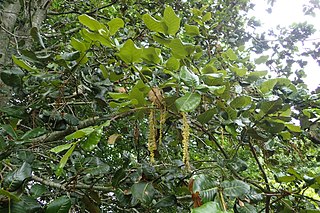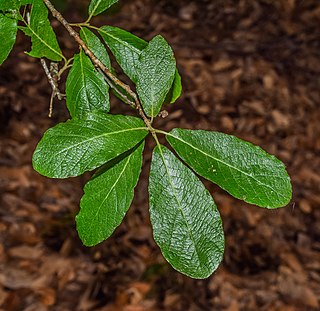
Quercus ilex, the evergreen oak, holly oak or holm oak is a large evergreen oak native to the Mediterranean region. It is a member of the Ilex section of the genus, with acorns that mature in a single summer.

Quercus wislizeni, known by the common name interior live oak, is an evergreen oak, highly variable and often shrubby, found in many areas of California in the United States continuing south into northern Baja California in Mexico. It generally occurs in foothills, being most abundant in the lower elevations of the Sierra Nevada, but also widespread in the Pacific Coast Ranges—where since 1980 it has been known as a separate species Quercus parvula—and the San Gabriel Mountains. It was named for its collector, Friedrich Adolph Wislizenus (1810–1889).

Quercus tomentella, the island oak, island live oak, or Channel Island oak, is an oak in the section Protobalanus. It is native to six islands: five of the Channel Islands of California and Guadalupe Island, part of Baja California.

Quercus dentata, also called Japanese emperor oak or daimyo oak is a species of oak native to East Asia. The name of the tree is often translated as "sweet oak" in English to distinguish it from Western varieties. It is placed in section Quercus.

Quercus canariensis, the Algerian oak, Mirbeck's oak or zean oak, is an oak native to southern Portugal, Spain, Tunisia, Algeria and Morocco. Despite the scientific name, it does not occur naturally today in the Canary Islands, though it may have in the past. It is placed in section Quercus.

Quercus benthamii is a species of oak in the family Fagaceae. It is native to the cloud forests of Central America and southern Mexico. It is threatened by habitat loss.

Quercus acuta, the Japanese evergreen oak, is an oak native to Japan, South Korea, Taiwan, and China's Guizhou Province and Guangdong Province. It is placed in subgenus Cerris, section Cyclobalanopsis.

Quercus geminata, commonly called sand live oak, is an evergreen oak tree native to the coastal regions of the subtropical southeastern United States, along the Atlantic Coast from southern Florida northward to southeastern Virginia and along the Gulf Coast westward to southern Mississippi, on seacoast dunes and on white sands in evergreen oak scrubs.

Quercus pyrenaica, also known as Pyrenean oak, or Spanish oak is a tree native to southwestern Europe and northwestern North Africa. Despite its common name, it is rarely found in the Pyrenees Mountains and is more abundant in northern Portugal and north and northwestern Spain.

Quercus franchetii, commonly known as the zhui lian li evergreen oak, is a species of oak in the Ilex section of the genus, native to a wide area of eastern Asia. It is an oak native to China, northern Thailand and Vietnam, growing at altitudes between 800 and 2,600 metres.

Quercus phillyreoides is a species of flowering plant in the genus Quercus, placed in subgenus Cerris and section Ilex. It is evergreen, withstands frost and can be grown in hardiness zone 7. It is native to southern China, the Ryukyu Islands, and Japan, and has been introduced to Korea.

Quercus margarettae, the sand post oak or dwarf post oak, is a North American species of oak in the beech family. It is native to the southeastern and south-central United States from Virginia to Florida and west as far as Texas and Oklahoma. There are historical reports of the species growing in New York State, but it has not been seen there in years.

Quercus elliptica is a Mesoamerican species of oak tree. It is widespread across central and southern Mexico and Central America from Sinaloa and Hidalgo south as far as Nicaragua. It is classified in Quercus sect. Lobatae.

Quercus semecarpifolia is an Asian species of oak. It is native to the Himalayas and nearby mountains in Tibet, Afghanistan, India, Nepal, and Pakistan, where it is referred to as kharsu. It is classified in subgenus Cerris, section Ilex.

Quercus eduardi is a species of oak tree. Q. eduardi is found in Sierra Fría, Aguascalientes, Mexico, between 2,200 and 2,600 metres above sea level. It is placed in Quercus section Lobatae.
Quercus lowii is a species of oak (Quercus) native to the mountains of northern Borneo.
Quercus look, the look oak or Mount Hermon oak, is a species of oak in subgenus Cerris, section Cerris, native to the Levant region of Western Asia, including northern Israel, Lebanon, and Syria. Of the local oak species, it prefers to grow at the highest altitudes, for instance at c. 1800 m on Mount Hermon.
Quercus pannosa is a species of oak native to south-central China. An evergreen tree or shrub, it is found at very high elevations, flourishing at up to 4,270 metres above sea level. It is classified in subgenus Cerris, section Ilex.

Quercus sideroxyla, called the Santa Rosa oak and encino colorado, is a species of oak native to northern and southwestern Mexico. Used for charcoal production, it prefers to grow at elevations from 1,800 to 2,700 metres. It is placed in section Lobatae.

Quercus spinosa is a species of oak native to central China, Taiwan and Myanmar, in the subgenus Cerris, section Ilex. An evergreen tree, its leaf traits may be adaptations to altitude. It is placed in section Ilex.


















